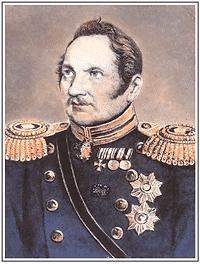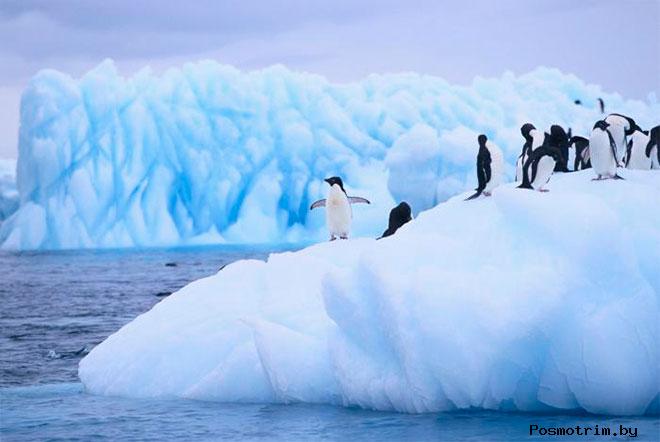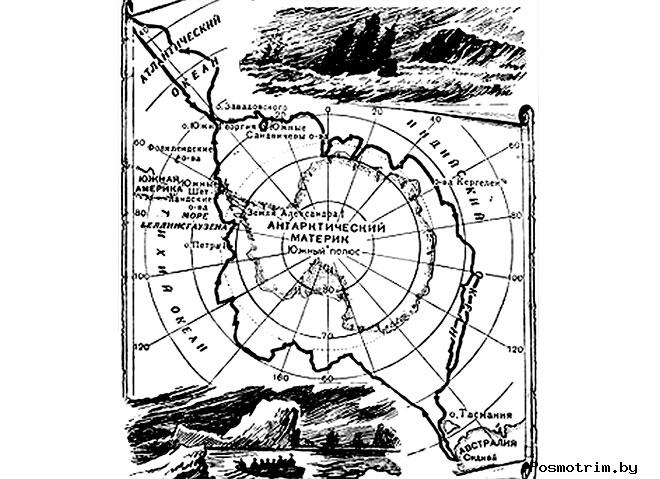In the photo: Slots "Vostok" and "Mirny" off the coast of Antarctica.
In 1820 there was discovered Antarctica, the last continent was plotted on the world map. There are no white spots left on the globe ... or rather, not so: a large white spot appeared on the globe quite "officially".
January 16 (28), 1820 - the day of the discovery of Antarctica by Russian travelers Bellingshausen and Lazarev

But Russian travelers, as they say, waved a pen to Antarctica from the side of the ship; the development of the mainland began much later - with the first wintering of the Norwegian expedition in 1895. True, the Americans claim that they were the first to land on the icy land, and already in 1821, but the debate over the historical validity of these statements is even hotter than on whether the Americans actually landed on the moon.
 Although, in fact, the development of Antarctica not only has not yet ended, but has not even really begun - the climate does not allow settling there on a permanent basis, so the meager "population" of the continent changes depending on the number of regular expeditions to polar stations ...
Although, in fact, the development of Antarctica not only has not yet ended, but has not even really begun - the climate does not allow settling there on a permanent basis, so the meager "population" of the continent changes depending on the number of regular expeditions to polar stations ...
Somewhere out there, under the ice cap of Antarctica, there is a land that keeps its secrets; paleontologists even claim that during the Mesozoic era, the climate on the mainland was quite mild. Will Antarctica become habitable again? In our century, it is unlikely, but in the distant future - who knows? Scientists continue their research ...
And further. Few are probably aware that Antarctica has its own flag. Why he is to her, it is not entirely clear, apparently, just “to be”, but he is and is a white silhouette of the continent, applied to the blue “ocean” field. Simple but tasteful. Well, to completely surprise the reader: Antarctica also has its own dialing code (+672) and an Internet domain (.aq).
Who knows, maybe it will come in handy?
Sasha Mitrakhovich 20.02.2018 09:40

Unknown Antarctica - "Terra Australis incognita" - unknown Southern land. The existence of Antarctica was known even in the ancient world.
The hypothesis of the existence of a southern continent was put forward by geographers of the ancient world, who had a penchant for symmetry and balance. There must be a large continent in the South, they postulated, in order to balance the large land mass in the Northern Hemisphere.
The hypothesis of ancient philosophers was also supported by scientists of the Middle Ages. Since the 16th century, this land has been placed on maps around the South Pole.
Two thousand years later, extensive experience in geographical research gave Europeans enough reason to turn their attention to the South to test this hypothesis.
The search for Antarctica was unsuccessfully carried out by the Portuguese B. Dias (1487-1488) and F. Magellan (1520), the Dutchman A. Tasman (1644).
Finally, the English navigator James Cook, after his voyage of 1772-1775, wrote:
"I went around the ocean of the Southern Hemisphere at high latitudes and did it in such a way that I undeniably rejected the possibility of the existence of the continent ... I can safely say that no man will ever dare to penetrate further south than I was able to."
Our sailors had a chance to refute this statement. Russian navigators V.M. Golovnin, I.F. Kruzenshtern, G.A. Sarychev and others have repeatedly advocated the need for further study of the southern polar seas. This idea was supported by the progressive public in Russia. And so, on July 3, 1819, Kronstadt solemnly conducted two long-distance expeditions at once. One went to explore the North Pacific, the other to the South Polar Region.
Sasha Mitrakhovich 20.02.2018 10:00

In the photo: Map of the voyage of the Bellingshausen and Lazarev expedition around Antarctica.
The honor of exploring the Antarctic seas fell to the crews of two sloops recruited from volunteers: Vostok and Mirny. Both ships were built in 1818, equipped and equipped for such a difficult and dangerous voyage. The ships were commanded by experienced officers of the Russian navy, Captain 2nd Rank F.F. Bellingshausen and Lieutenant M.P. Lazarev. This was the first major naval expedition undertaken at public expense and under the leadership of the Naval Ministry.
Everyone understood that the main goal of the expedition was to answer the question: is there a sixth continent - Antarctica. But even the most determined of its organizers could not have foreseen such impressive results in the form of the discovery of the sixth continent and twenty-nine new islands. This was an outstanding contribution of Russian sailors to the study of our planet.
Russian expedition to Antarctica
The initial stage of this voyage took place along the route already familiar to Russian sailors to Rio de Janeiro. Entering Antarctic waters, "Vostok" and "Mirny" made a hydrographic inventory of the southwestern shores of South Georgia Island. Then the expedition discovered a whole archipelago, named after the Russian naval minister de Traversay.
Skillfully maneuvering among icebergs and large ice fields, often in fog, the brave Russian explorers reached 69 ° 21'S on January 16, 1820. sh. almost on the Greenwich meridian, and discovered Antarctica. Then the ships approached the icy shores twice more, and in mid-February, with the Antarctic autumn approaching, headed for Sydney for a short rest.
Discovery of new lands in the Antarctic expedition
Having made repairs and replenishing supplies, "Vostok" and "Mirny" on May 8, 1820 went to the tropical part of the Pacific Ocean, where a group of islands was discovered in the Paumotu archipelago, called the Bellingshausen Islands of the Russians. Vostok Island was discovered in the Cook Islands group, and Mikhailov and Simonov Islands were discovered in the Fiji Islands area, after which the ships returned to Sydney.
The second assault on the Antarctic latitudes began on October 31. Neither ice nor storms could break the will of the brave sailors. The sloops crossed the Antarctic Circle twice. On January 10, 1821, they discovered a large island, named after the founder of the Russian fleet, Peter I, and a week later - the mountainous coast of Alexander I. From here the ships went to the South Shetland Islands, where two archipelagos were discovered and described, the islands of which were named in honor of victories Russian army in the Patriotic War of 1812.
Expedition results
On January 30, the detachment left Antarctica. Having successfully completed this historic voyage around the world, "Vostok" and "Mirny" on July 24, 1821 gave up anchors on the Great Kronstadt roadstead. Expedition F.F. Bellingshausen and M.P. Lazareva walked about 50 thousand miles and spent 751 days sailing.
She collected the most valuable information about the nature of the Southern Hemisphere. Astronomical definitions of geographic coordinates, and the maps compiled by the expedition, were extremely accurate. Unique scientific observations of sea currents and sea waves, distribution of ice and icebergs were carried out near the ice continent. Based on the data of magnetic observations, Bellingshausen calculated the coordinates of the magnetic pole in the Southern Hemisphere for 1819-1821.
And in general, climate change will lead to the death of plants and animals, which in turn will have a detrimental effect on human life. On the other hand, a softening of the climate to a more comfortable one can even lead to the settlement of Antarctica and its more active development, which, undoubtedly, could be a unique experience for humans.
Antarctica keeps a lot of mysteries and can surprise mankind with various metamorphoses. It is quite possible that in 100-200 years this kingdom of the Snow Queen will appear before us in a completely unusual and unexpected form.
The work of domestic discoverers was successfully continued by Soviet scientists who occupied leading positions in the study of Antarctica. Today, Russia is gradually regaining its former glory in the exploration and exploitation of Antarctic resources.
Sasha Mitrakhovich 20.02.2018 10:22




